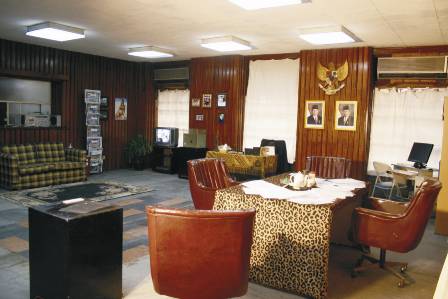 |
|
|---|---|
| CP Foundation | About CP Biennale | 2003 | 2005 | Contact Us | |
         
|
|
|
Cetak Urban ruangrupa, founded in 2000 by the initiatives of a group of Jakartan artists, is a not-for-profit organization active in holding efforts to develop art ideas. The group is a part of the RAIN Artists' Initiative International Network, a network of artists' initiatives and art institutions in numerous countries. ruangrupa holds a myriad of programs, such as the artist-in-residence program, art workshops, research and documentation, discussions, screening of video art, short films, experimental works, music video, and works of digital manipulations. ruangrupa also provides an exhibition room, a living space, working space, and computer facilities for digital image developing, and sound and video editing. The community also has Karbon, an art journal published every four months. Some of the activities held by the group include:"JAKARTA 32°C," an exhibition, workshop, discussion, work presentation, and film screening at the National Gallery, Jakarta (2004); "Trotoart" (Jakarta – Indonesia) and Nilsmagnus Skold (Malmo, Sweden) (2004); "Secrets/No Secrets" exhibition (2003); "OK Video," Video Art Exhibition at the National Gallery, Jakarta (2003); and an artist-in-residence and collaborative program "Short Message System" with Tina Gillen from Belgia/Luksemburg (2002). (From "Sebelas Tesis tentang Cetak Urban" by Ronny Agustinus, in Karbon-Jurnal Seni Rupa: Cetak Urban, Yang Personal di Atas Tafsiran Sosiologis vol: 2 02/2001) Urban environment and its problems always become a main focus in every artwork of ruangrupa. One of the problems that we've tackled and constantly analyzed is the visual culture phenomena, especially the urban print culture. ruangrupa presents a documentation and work in video, digital prints, and other print materials, from projects since 2000 – 2005, with the main focus on urban print culture. Most of this material will be re-worked and developed as a presentation form. This projects involves several artists, producer, and researcher, who analyze, ask, "play," or re-construct the phenomena of the urban print as a medium of idea presentation, with its many social-cultural relations. (Artist's Statement) |
|
|
CP foundation | About CP Biennale | 2005 Biennale | 2003 Biennale | Contact Us
Jl. Suryopranoto 67A, Jakarta 10160, Indonesia. ph. +62.21.3448126, 3853206 | fax. +62.21.3853203, 3853208 info@cp-foundation.org |


